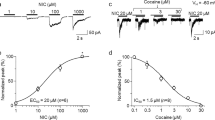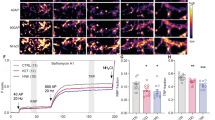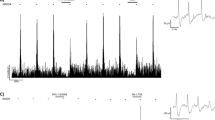ABSTRACT
Zinc and nicotinic acetylcholine receptors (nAChRs) seem to be associated with major depression, and some antidepressants, including fluoxetine (Prozac), antagonize nAChRs. Therefore, a study was made of the modulation of neuronal α4β4 and muscle α1β1γδ nAChRs, expressing in oocytes, by the combined action of zinc and fluoxetine. At a holding potential of –60 mV, 200 μM zinc increased by 361% the currents elicited by acetylcholine (ACh currents) for α4β4 and by 182% for α1β1γδ nAChRs. In contrast, 5 μM fluoxetine reduced the ACh currents to 31% for α4β4 and to 45% for α1β1γδ nAChRs. Additionally, fluoxetine reduced more the ACh currents in the presence of zinc: to 17% for α4β4 and to 19% for α1β1γδ nAChRs, and after washing out the fluoxetine the ACh current did not recover its zinc-potentiated value. Moreover, when ACh-activated nAChRs were exposed first to fluoxetine and then zinc was added, the potentiating effect of zinc was very small for muscle nAChRs and was nil for neuronal receptors. Thus, the inhibiting effect of fluoxetine prevails over the potentiating action of zinc. Finally, the effects of both zinc and fluoxetine were voltage independent, indicating that these substances interact outside the ion channel. As fluoxetine nullifies the effects of zinc, it appears that both substances interact in the same site. These results should help understand better the roles played by zinc, antidepressants, nAChRs and their combination in brain functions and in the treatment of depression.
This is a preview of subscription content, access via your institution
Access options
Subscribe to this journal
Receive 6 print issues and online access
$259.00 per year
only $43.17 per issue
Buy this article
- Purchase on Springer Link
- Instant access to full article PDF
Prices may be subject to local taxes which are calculated during checkout



Similar content being viewed by others
References
Levin ED . Nicotinic receptor subtypes and cognitive function. J Neurobiol 2002; 53: 633–640.
Picciotto MR, Brunzell DH, Caldarone BJ . Effect of nicotine and nicotinic receptors on anxiety and depression. NeuroReport 2002; 13: 1097–1106.
Vizi ES, Lendvai B . Modulatory role of presynaptic nicotinic receptors in synaptic and non-synaptic chemical communication in the central nervous system. Brain Res Brain Res Rev 1999; 30: 219–235.
Cockcroft VB, Ortels M, Lunt GG . Ligands, receptor models, and evolution. Ann N Y Acad Sci 1995; 757: 40–47.
García-Colunga J, Miledi R . Opposite effects of lanthanum on different types of nicotinic acetylcholine receptors. NeuroReport 1997; 8: 3293–3296.
García-Colunga J, González-Herrera M, Miledi R . Modulation of nicotinic acetylcholine receptors by zinc. NeuroReport 2001; 12: 147–150.
Hsiao B, Dweck D, Luetje CW . Subunit-dependent modulation of neuronal nicotinic receptors by zinc. J Neurosci 2001; 21: 1848–1856.
Palma E, Maggi L, Miledi R, Eusebi F . Effects of Zn2+ on wild and mutant neuronal α7 nicotinic receptors. Proc Natl Acad Sci USA 1998; 95: 10246–10250.
García-Colunga J . Serotonergic modulation of nicotinic acetylcholine receptors. Synaptic transmission 100 years after Luigi Luciani. Symposium in honour of Ricardo Miledi, Rome, Italy, 2000; pp 43–44.
García-Colunga J, Miledi R . Effects of serotonergic agents on neuronal nicotinic acetylcholine receptors. Proc Natl Acad Sci USA 1995; 92: 2919–2923.
García-Colunga J, Miledi R . Serotonergic modulation of muscle acetylcholine receptors of different subunit composition. Proc Natl Acad Sci USA 1996; 93: 3990–3994.
García-Colunga J, Miledi R . Blockage of mouse muscle nicotinic acetylcholine receptors by serotonergic compounds. Exp Physiol 1999; 84: 847–864.
Grassi F, Polenzani L, Mileo AM, Caratsch CG, Eusebi F, Miledi R . Blockage of nicotinic acetylcholine receptors by 5-hydroxytryptamine. J Neurosci Res 1993; 34: 562–570.
García-Colunga J, Awad JN, Miledi R . Blockage of muscle acetylcholine receptors by the serotonin 1A receptor agonist 8-hydroxy-2-(di-n-propylamino)tetralin (8-OH-DPAT). Biomed Res 1997; 18: 307–311.
Fryer JD, Lukas RJ . Antidepressants noncompetitively inhibit nicotinic acetylcholine receptor function. J Neurochem 1999; 72: 1117–1124.
García-Colunga J, Awad JN, Miledi R . Blockage of muscle and neuronal nicotinic acetylcholine receptors by fluoxetine (Prozac). Proc Natl Acad Sci USA 1997; 94: 2041–2044.
Hennings ECP, Kiss JP, De Oliveira K, Toth PT, Vizi ES . Nicotinic acetylcholine receptor antagonism activity of monoamine uptake blockers in rat hippocampal slices. J Neurochem 1999; 73: 1043–1050.
López-Valdés H, García-Colunga J . Antagonism of nicotinic acetylcholine receptors by inhibitors of monoamine uptake. Mol Psychiatry 2001; 6: 511–519.
López-Valdés HE, García-Colunga J, Miledi R . Effects of clomipramine on neuronal nicotinic acetylcholine receptors. Eur J Pharmacol 2002; 444: 13–19.
Maggi L, Palma E, Miledi R, Eusebi F . Effects of fluoxetine on wild and mutant neuronal α7 nicotinic receptors. Mol Psychiatry 1998; 3: 350–355.
Shytle RD, Silver AA, Lukas RJ, Newman MB, Sheehan DV, Sanberg PR . Nicotinic acetylcholine receptors as targets for antidepressants. Mol Psychiatry 2002; 7: 525–535.
Frederickson CJ, Suh SW, Silva D, Frederickson CJ, Thompson RB . Importance of zinc in the central nervous system: the zinc-containing neuron. J Nutr 2000; 130 (Suppl): 1471S–1483S.
Birinyi A, Parker D, Antal M, Shupliakov O . Zinc co-localizes with GABA and glycine in synapses in the lamprey spinal cord. J Comp Neurol 2001; 433: 208–221.
Howell GA, Welch MG, Frederickson CJ . Stimulation-induced uptake and release of zinc in hippocampal slices. Nature 1984; 308: 736–738.
Assaf SY, Chung SH . Release of endogenous Zn2+ from brain tissue during activity. Nature 1984; 308: 734–736.
Harrison NL, Gibbons SJ . Zn2+: an endogenous modulator of ligand- and voltage-gated ion channels. Neuropharmacology 1994; 33: 935–952.
Maes M, Vandoolaeghe E, Neels H, Demedts P, Wauters A, Meltzer HY et al. Lower serum zinc in major depression is a sensitive marker of treatment resistance and of the immune/inflammatory response in that illness. Biol Psychiatry 1997; 42: 349–358.
Nowak G, Szewczyk B . Mechanisms contributing to antidepressant zinc actions. Pol J Pharmacol 2002; 54: 587–592.
Nowak G, Szewczyk B, Sadlik K, Piekoszewski W, Trela F, Florek E et al. Reduced potency of zinc to interact with NMDA receptors in hippocampal tissue of suicide victims. Pol J Pharmacol 2003; 55: 455–459.
Nowak G, Szewczyk B, Wieronska JM, Branski P, Palucha A, Pilc A et al. Antidepressant-like effects of acute and chronic treatment with zinc in forced swim test and olfactory bulbectomy model in rats. Brain Res Bull 2003; 61: 159–164.
Rosa AO, Lin J, Calixto JB, Santos AR, Rodrigues AL . Involvement of NMDA receptors and L-arginine-nitric oxide pathway in the antidepressant-like effects of zinc in mice. Behav Brain Res 2003; 144: 87–93.
Kroczka B, Branski P, Palucha A, Pilc A, Nowak G . Antidepressant-like properties of zinc in rodent forced swim test. Brain Res Bull 2001; 55: 297–300.
Nowak G, Siwek M, Dudek D, Zieba A, Pilc A . Effect of zinc supplementation on antidepressant therapy in unipolar depression: a preliminary placebo-controlled study. Pol J Pharmacol 2003; 55: 1143–1147.
Wong DT, Bymaster FP, Engleman EA . Prozac (Fluoxetine, Lilly 110140), the first selective serotonin uptake inhibitor and an antidepressant drug: twenty years since its first publication. Life Sci 1995; 57: 411–441.
Popik P, Kozela E, Krawczyk M . Nicotine and nicotinic receptor antagonists potentiate the antidepressant-like effects of imipramine and citalopram. Br J Pharmacol 2003; 139: 1196–1202.
Sharma G, Vijayaraghavan S . Modulation of presynaptic store calcium induces release of glutamate and postsynaptic firing. Neuron 2003; 38: 929–939.
Goodnick PJ . Pharmacokinetics of second generation antidepressants: fluoxetine. Psychopharmacol Bull 1991; 27: 503–512.
Karson CN, Newton JE, Livingston R, Jolly JB, Cooper TB, Sprigg J et al. Human brain fluoxetine concentrations. J Neuropsychiatry Clin Neurosci 1993; 5: 322–329.
Nowak G, Schlegel-Zawadzka M . Alterations in serum and brain trace element levels after antidepressant treatment: Part I. Zinc. Biol Trace Elem Res 1999; 67: 85–92.
Szewczyk B, Branski P, Wieronska JM, Palucha A, Pilc A, Nowak G . Interaction of zinc with antidepressants in the forced swimming test in mice. Pol J Pharmacol 2002; 54: 681–685.
Miledi R, Woodward RM . Effects of defolliculation on membrane current responses of Xenopus oocytes. J Physiol (Lond) 1989; 416: 601–621.
Miledi R . A calcium-dependent transient outward current in Xenopus laevis oocytes. Proc R Soc Lond 1982; B215: 491–497.
Acknowledgements
We are grateful to Drs J Boulter and S Heinemann (the Salk Institute) for providing the nicotinic acetylcholine receptor clones. This work was supported by Grants from the Consejo Nacional de Ciencia y Tecnología, México 35033-N (to JGC), G25775N (to JGC and RM), a CONACYT scholarship (to EVG) and by a National Science Foundation (Neuronal and Glial Mechanisms) Grant 998285 (to RM).
Author information
Authors and Affiliations
Corresponding author
Additional information
DUALITY OF INTEREST
None declared.
Rights and permissions
About this article
Cite this article
García-Colunga, J., Vázquez-Gómez, E. & Miledi, R. Combined actions of zinc and fluoxetine on nicotinic acetylcholine receptors. Pharmacogenomics J 4, 388–393 (2004). https://doi.org/10.1038/sj.tpj.6500275
Received:
Revised:
Accepted:
Published:
Issue Date:
DOI: https://doi.org/10.1038/sj.tpj.6500275
Keywords
This article is cited by
-
The GABAergic deficit hypothesis of major depressive disorder
Molecular Psychiatry (2011)



